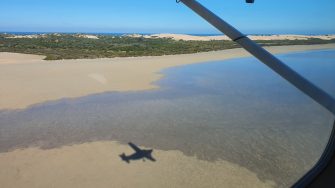
Date: Wednesday, October 28, 2020
Project: Eastern Australian Waterbird Survey
Observers: Richard Kingsford UNSW, John Porter UNSW/DPIE
Pilot: James Barkell NSW National Parks & Wildlife Service DPIE
It was stunning at daybreak, with not a breath of wind. Ideal conditions for doing the Coorong flight. More often than not, we have surveyed the Coorong in a blowing gale, causing turbulence as it blows over the dunes, bumping the plane around. Today was a great flight. We met our South Australian colleagues from the Department of Environment and Water. These intensive times of counting waterbirds provide us with an opportunity to train new waterbird counters from our collaborating state agencies. Our trainee waterbird counters spent a few intensive hours in the plane, sitting behind an experienced counter and practicing their identifications and estimates of different species of waterbirds while hearing an experienced counter.
We headed south over the town of Goolwa, down to the Murray mouth. It was a beautiful morning.
The sun was coming over the horizon, catching the fog nestling in the dunes. Even the early signs were surprising here at the Murray Mouth, with relatively few waterbirds.
In past years clouds of grey and chestnut teal took off in in front of the aeroplane as we flew the Murray Mouth, along with hundreds of small waders, avocets, and flocks of banded stilts. But not today. There were only a few flocks of grey and chestnut teal and lots of silver gulls. The other numerous species was Australian shelduck but even their numbers weren’t as high as in previous years.
There was one other noticeable difference. The shoreline of the North and South Coorong had dried right back considerably. In past years, the water was right up to the edge of the wetland. But today, you could see many more extensive beaches of sand along the edge of the North and South Coorong. There were also more ‘islands’ popping out than previous years because the water was so shallow.
There was a small colony of pelicans on the island where they usually nest, as well as a small colony of terns on another island in the South Coorong.
The other surprise was how much the end of the South Coorong had retracted. It was well short of the extent we had surveyed in the past, with now an extensive length of sand.
After flying the western shoreline, we got to the end of the South Coorong and headed even further south to band two of our eastern Australian waterbird survey. Normally, we do not do this. We usually survey this eastern part of band 2 when we fly up from completing band 1 in Victoria. But this is not a normal year. And so we took the opportunity to survey the interdunal swamps, known as the Water Valley wetlands, just south of the Coorong. But first we surveyed the saline lakes which run parallel to the ocean, south of the Coorong. These quite often have lots of teal and stilts. But again, not today. There were a few silver gulls, black swans and mountain duck but that was about all. After this we headed east, along Band 2. It was quite a surprise to find so little water down here in the Water Valley Wetlands. We had expected that these wetland systems would have lots of flooding. We only found one or two wetlands with water. These wetlands have thousands of waterbirds when they have water. There were probably only a few 100 waterbirds today. You could see that most of the wetlands were dry, probably reflecting a pretty dry winter rainfall pattern, critical because they rely on local rainfall. The large drain takes water from these wetlands, reducing their flooding, a major destructive blow to these ecosystems some time ago.
Once we had finished flying about 50 kilometres inland, we turned back to the South Coorong and flew up the western shoreline of the South and North Coorong back to Goolwa. The pattern in the North and South Coorong was the same. There were very few waterbirds compared to previous years. Just lots of silver gulls and not a lot more, even when we flew past the barrages where lots of waterbirds can congregate when the fresh water gushes out of the lakes and into the Coorong. Today, there were only a few cormorants, whiskered terns, pelicans and a few swans. And a few seals.
In the afternoon, we did it all again – our second count. The low numbers of waterbirds may also be due to the inland rains and floods. They don’t seem to be as extensive as they were in 2016 across the Murray-Darling Basin and there seemed to be more waterbirds down here in the Lower Lakes, Murray Mouth and Coorong. But perhaps when we get up into Lake Eyre Basin and north coast of Queensland, we'll see many more flooded wetland habitats than in other years. We’ll find out more next week when we have permission to survey the wetlands in Queensland.
Blog by Richard Kingsford
